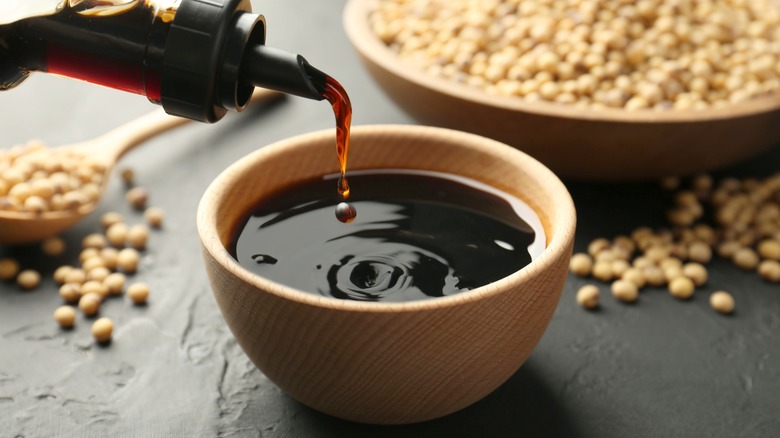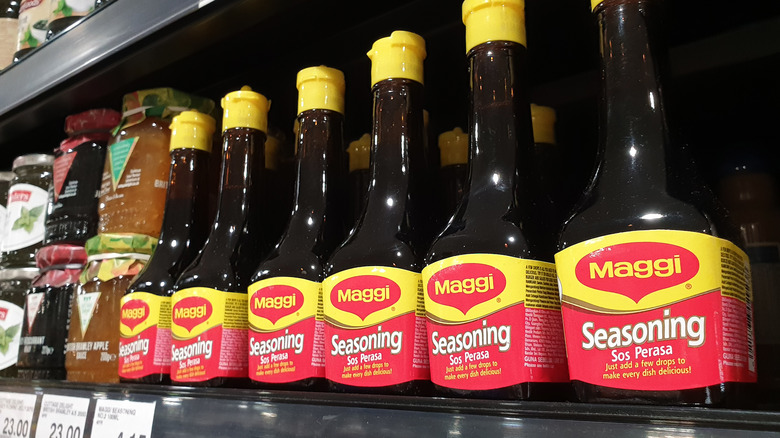Liquid Seasoning Vs Soy Sauce: What's The Difference?
We may receive a commission on purchases made from links.
If you're looking to swap in an ingredient for soy sauce but feel confused by the idea of liquid seasoning, you're not alone. Liquid seasoning is one of the most bafflingly generic names for any food product on store shelves, offering no clue as to what lies inside the bottle other than a liquid used to season food. It's also a product that doesn't always go by that name, with some brands just calling it "seasoning" (no help there) or liquid aminos (liquid what?). Nonetheless, it's something you see offered as a substitute for soy sauce, and you'll find it at most every grocery store. In fact, a lot of chefs swear by liquid seasoning as a fantastic secret ingredient.
The reason the two are considered somewhat interchangeable is because they are both derived from plant proteins, and both add an umami-rich flavor to dishes. However, unlike soy sauce, some (but not all) brands of liquid seasoning are gluten-free, which explains part of why you see them offered as alternatives. To add to the confusion, not all liquid seasoning brands are made the same way, and they often taste different from each other, much like the variations between different types of soy sauce. And while soy sauce is a pretty ancient ingredient that has evolved over time, liquid seasoning is a newer creation, which accounts for a lot of its differences with soy sauce. So what really sets them apart?
What is soy sauce?
Soy sauce is a fermented condiment made from soybeans and wheat, which is why it's not gluten-free. Its creation dates back thousands of years to China, and it has since become a staple in East Asian cuisine. Coming from soybeans, it is related to miso; Japanese versions of soy sauce actually started out as pastes. Modern soy sauce is made by combining cooked soybeans with roasted wheat, and then adding certain molds, bacteria, and salt water. The mixture then sits to ferment, usually six months at minimum, developing more flavor before it gets bottled and sold. Interestingly, the color of soy sauce comes from the Maillard reaction, the same process that occurs when you brown foods, because of the sugar that is created during fermentation.
That fermentation is also responsible for soy sauce's unique flavor. The process breaks down the protein from the soybeans, which gives the sauce its strong umami undertones and produces MSG (or monosodium glutamate), that signature salty-umami taste popular in Asian dishes. Combined with the wheat and brine, you get a condiment that is heavily salty, savory, and a little sweet. Beyond that base, soy sauce can also come in different forms that change the flavor. Light soy sauce is thinner and saltier, while dark soy sauce is thicker and sweeter, and sometimes contains additions like molasses. The flavor of soy sauce will vary by country of origin as well.
What is liquid seasoning?
Liquid seasoning and it's various offshoots are essentially concentrated forms of the same kinds of plant proteins that produce soy sauce. However, depending on the brand you use, they comes from different sources. Liquid aminos, like the popular Bragg brand, are made from soybean amino acids, while Maggi seasoning, another popular brand, is made from wheat. Both are made by hydrolyzing the proteins in their plant bases, which means soybeans are soaked in hydrochloric acid until they break down into their basic proteins. Like soy sauce, this process produces molecules very similar to MSG, giving liquid seasoning an extremely savory taste.
This hydrolyzing process makes liquid seasoning intense and complex in flavor, just like soy sauce, so very little of it is usually added to dishes. The MSG and similar compounds also give it the same umami notes as soy sauce. The big difference in flavor comes from the lack of added salt. While brands like Bragg and Maggi will differ in how salty they taste, both contain less sodium than soy sauce. And like soy sauce, liquid seasoning can differ in intensity of flavor between brands — so be careful if you alternate between different options, as Maggi can be more overpowering than Bragg. It won't be a perfect swap for soy sauce because of the less salty flavor, but liquid seasoning does have a meaty, umami flavor which has made names like Maggi transcend culinary borders.


